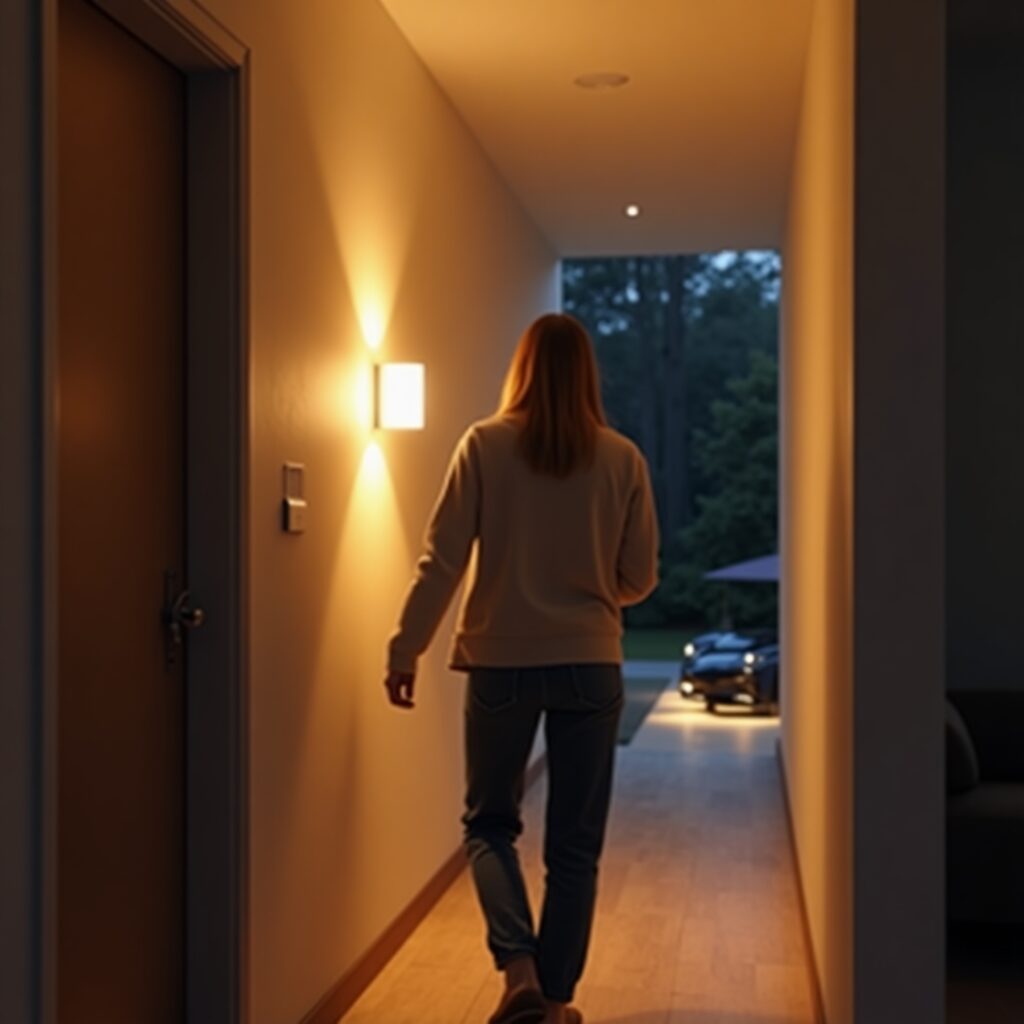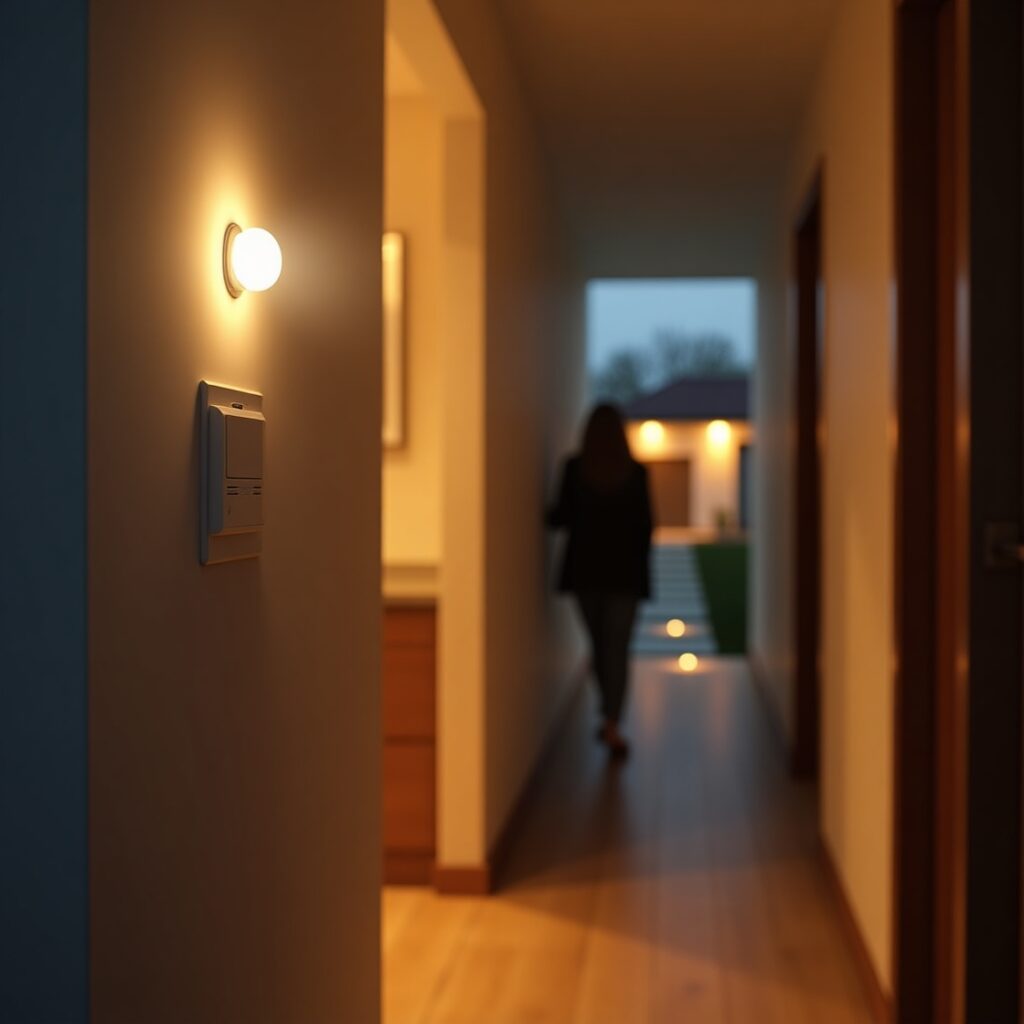Automating your home’s lighting system offers unparalleled convenience, energy savings, and enhanced security. One of the most practical ways to achieve this is by using motion sensors. Imagine walking into a room, closet, or garage, and the lights simply turn on without you having to fumble for a switch. This guide will walk you through the process, focusing on how to install a motion sensor light switch, explore wireless options, and discuss how to connect motion sensor to smart home lights.

Manually flipping switches is a habit we’ve lived with forever, but it’s far from the most efficient method. Lights are often left on unnecessarily, wasting energy and increasing utility bills. Motion sensor lighting solves this by ensuring lights are only active when someone is present. Consequently, this can lead to significant energy savings over time. Furthermore, for areas like garages or outdoor pathways, motion-activated lights can deter intruders, adding a layer of security.
Understanding Different Motion Sensor Lighting Systems
Before diving into installation, it’s helpful to understand the various types of motion sensor lighting systems available for your home.
Wired Motion Sensor Light Switches
These devices replace your existing light switch and integrate directly into your home’s electrical wiring. They are a popular choice for indoor areas like hallways, pantries, bathrooms, and closets. Installing one typically involves replacing the standard switch with a motion-sensing unit. This process requires working with electrical wires, so understanding basic wiring principles is crucial. We’ll cover how to wire motion light switch replacements in detail later.
Wireless and Battery-Powered Motion Lights
For locations where running new wires isn’t feasible or desirable, battery powered motion lights or wireless systems are excellent alternatives. These often consist of a battery-operated sensor and a separate light fixture (or integrated unit) that communicate wirelessly. They are perfect for a quick motion sensor light setup for closet, under cabinets, or in shed interiors. The ease of installation makes them a popular diy motion activated lighting project.
Integrating Motion Sensors with Smart Home Lights
In the age of smart homes, you can also connect motion sensor to smart home lights. This setup usually involves a smart motion sensor (often battery-powered and wireless) that communicates with a smart hub or directly with smart bulbs or switches via protocols like Wi-Fi, Zigbee, or Z-Wave. This allows for more complex automation rules – like turning on lights to a specific brightness or color, or triggering other smart devices – and is a key aspect of creating a comprehensive wireless motion sensor light system home.
Step-by-Step: How to Install a Wired Motion Sensor Light Switch
If you’re looking to replace light switch motion sensor, this section is for you. While the exact steps may vary slightly depending on the specific model and your home’s wiring, the general process is outlined below. Installing a motion sensor light switch is a common home improvement task, but it requires caution.
Safety First!
Always turn off power to the circuit you’ll be working on at the main breaker panel. Use a non-contact voltage tester to confirm the power is off at the switch box before touching any wires.
Gathering Tools and Materials
You’ll need:
- New motion sensor light switch
- Flathead and Phillips head screwdrivers
- Wire strippers
- Needle-nose pliers
- Electrical tape
- Non-contact voltage tester
- Wire nuts (usually included with the switch)
The Installation Process
Once the power is off:
- Remove the cover plate from the existing switch.
- Unscrew the old switch from the electrical box.
- Carefully pull the old switch out of the box, leaving the wires connected for now.
- Observe and note how the wires are connected to the old switch. Typically, you’ll see a hot wire (often black, connected to a brass or black terminal), a load wire (going to the light fixture, often black or red, connected to a brass or black terminal), and potentially a neutral wire (white, connected to a silver terminal) or a ground wire (bare copper or green, connected to a green screw). Not all older switch boxes have a neutral wire, which is required by many modern motion sensor switches. Check your new switch’s requirements.
- Disconnect the wires from the old switch.
- Connect the wires to the new motion sensor switch according to the manufacturer’s instructions. A typical motion sensor light switch wiring diagram involves connecting the line (hot) wire to the line terminal on the switch, the load wire to the load terminal, the neutral wire (if present and required) to the neutral terminal, and the ground wire to the ground screw. [Image: Diagram showing typical motion sensor light switch wiring, Alt: Wiring diagram illustrating connections for line, load, neutral, and ground wires on a motion sensor light switch]
- Carefully fold the wires back into the electrical box.
- Screw the new motion sensor switch into the box.
- Attach the new cover plate.
Testing and Adjustment
Turn the power back on at the breaker. Test the switch. Most motion sensor switches have adjustable settings for sensitivity (how easily it detects motion) and time delay (how long the light stays on after motion stops). Learn how to adjust sensitivity motion sensor light and time delay using the small dials or buttons on the switch according to the manual.
[Internal Link: A related article about understanding home electrical wiring]
Setting Up Wireless and Smart Home Systems
For wireless or smart home setups, the process is generally simpler and doesn’t require electrical wiring knowledge (unless you’re installing a smart switch or bulb). For a motion sensor light setup for closet using battery power, you simply mount the sensor and the light fixture using adhesive or screws. [Image: Photo of a small battery-powered motion sensor light in a closet, Alt: Small LED light strip and separate motion sensor mounted inside a dark closet] For smart home integration, you typically pair the smart motion sensor with your smart hub or app, and then create automation rules to control your smart lights when motion is detected. This is how you effectively integrate motion sensor smart lights into a cohesive system. A motion sensor light for garage security might involve an outdoor-rated wireless sensor triggering a smart outdoor light.
Troubleshooting Common Issues
Encountering issues? Here’s a quick guide to troubleshooting motion sensor light not working:
- Light stays on: Check the time delay setting. Ensure the sensor isn’t blocked or detecting constant motion (e.g., a fan, pet, or heat source).
- Light doesn’t turn on: Verify power is on. Check wiring connections (if wired). Ensure the bulb isn’t burnt out. Check the sensor’s range and sensitivity settings. For wireless, check batteries and pairing.
- Light flickers: Could be a loose connection, incompatible bulb type (some motion switches require specific bulb types like incandescent or dimmable LEDs), or a faulty sensor.
[External Link: A reputable source for electrical safety guidelines]
[Internal Link: A related article about choosing the right smart home devices]
Benefits Beyond Convenience
As mentioned earlier, the benefits of motion sensor lighting home are numerous. Beyond convenience, they provide significant energy savings by ensuring lights aren’t left on unnecessarily. This contributes to lower electricity bills and a reduced carbon footprint. Furthermore, motion-activated lights are a proven deterrent for potential intruders, especially in outdoor or garage areas, enhancing your home’s security profile.
DIY Considerations
Undertaking a diy motion activated lighting project can be rewarding. Battery-powered and wireless systems are generally beginner-friendly. Replacing a standard light switch with a wired motion sensor switch is a moderate difficulty project that requires basic electrical knowledge and strict adherence to safety protocols. If you’re uncomfortable working with wiring, it’s always best to consult a qualified electrician.
Conclusion
Automating your home lights with motion sensors is a smart upgrade that enhances convenience, saves energy, and improves security. Whether you choose to wire motion light switch replacements, opt for simple battery powered motion lights, or fully integrate motion sensor smart lights into your existing smart home system, there’s a solution for every need and skill level. By following safety guidelines and understanding the different system types, you can successfully implement motion-activated lighting throughout your home.
Ready to make your home smarter and more efficient? Subscribe to our newsletter for more smart home tips and DIY guides! Check out our related services for professional installation options.
